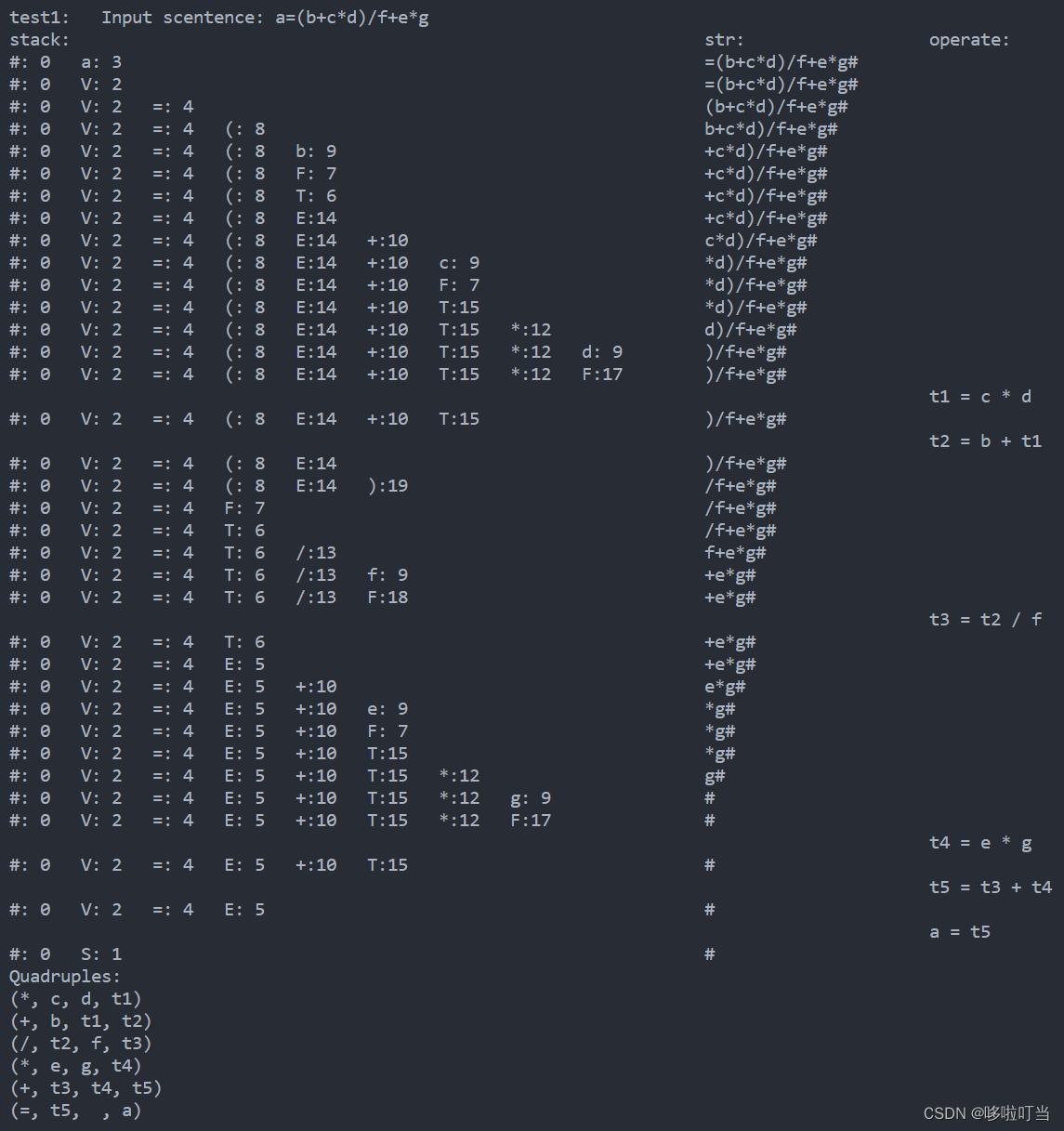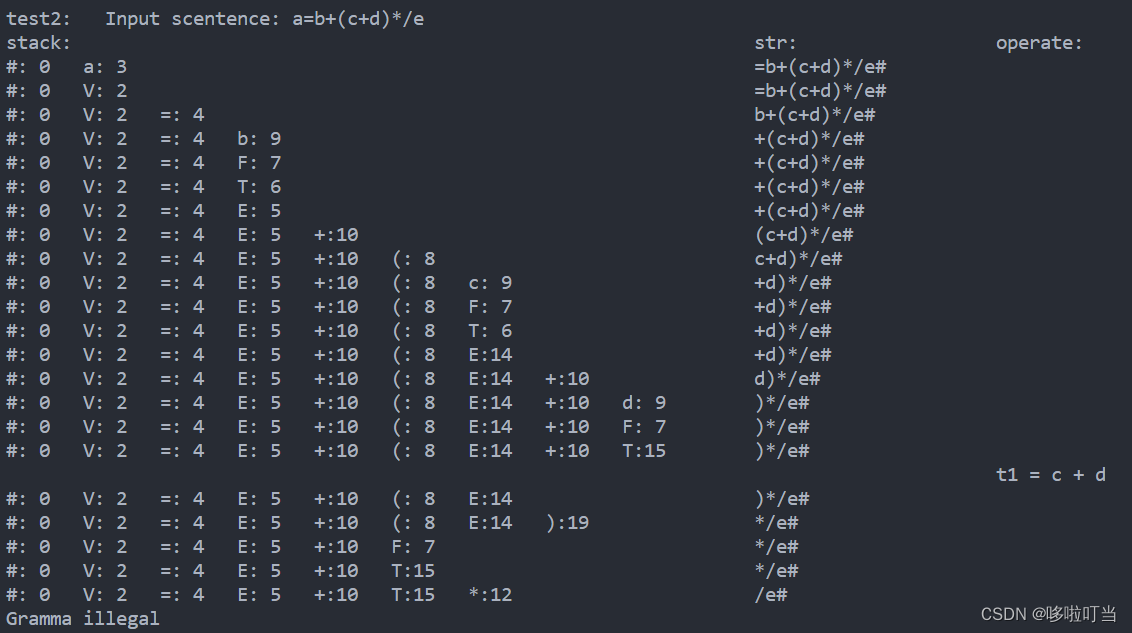制作一个简单的C语言词法分析程序_c语言编写词法分析程序-CSDN博客 https://blog.csdn.net/lijj0304/article/details/134078944?spm=1001.2014.3001.5501前置程序词法分析器参考这个帖子⬆️
https://blog.csdn.net/lijj0304/article/details/134078944?spm=1001.2014.3001.5501前置程序词法分析器参考这个帖子⬆️
代码仓库:JJLi0427/compiler (github.com)
1.程序目标
算符优先语法分析程序,程序可以识别实验1的输出文件中的二元序列,然后通过已经构造好的SLR1分析表,进行语法分析,程序能够实时输出分析栈的状态,遇到错误位置会停止,对于正确的语句可以输出对应的四元式序列。算式的语法如下:
G[S]:S→V=E
E→E+T∣E-T∣T
T→T*F∣T/F∣F
F→(E)∣i
V→i
2.程序设计
SLR1语法分析部分是通过提前根据语法构造分析表,分析表以数组的形式存储,数组中存储了每个状态遇到的终结符和非终结符对应的动作和转移到的状态。大于0表示移进操作,小于0表示先规约后移进操作,0表示为不存在的状态,遇到则需要报错。
根据文法构造SLR1分析表:
S‘→S
S→V=E
E→E+T
E→E-T
E→T
T→T*F
T→T/F
T→F
F→(E)
F→i
V→i
| GOTO | ACTION | |||||||||||||
| i | = | + | - | * | / | ( | ) | # | S | E | T | F | V | |
| 0 | S3 | 1 | 2 | |||||||||||
| 1 | ACC | |||||||||||||
| 2 | S4 | |||||||||||||
| 3 | R10 | R10 | R10 | R10 | R10 | R10 | R10 | R10 | R10 | |||||
| 4 | S9 | S8 | 5 | 6 | 7 | |||||||||
| 5 | R1 | R1 | S10 | S11 | R1 | R1 | R1 | R1 | R1 | |||||
| 6 | R4 | R4 | S12 | S13 | R4 | R4 | R4 | R4 | R4 | |||||
| 7 | R7 | R7 | R7 | R7 | R7 | R7 | R7 | R7 | R7 | |||||
| 8 | S9 | S8 | 14 | 6 | 7 | |||||||||
| 9 | R9 | R9 | R9 | R9 | R9 | R9 | R9 | R9 | R9 | |||||
| 10 | S9 | S8 | 15 | 7 | ||||||||||
| 11 | S9 | S8 | 16 | 7 | ||||||||||
| 12 | S9 | S8 | 17 | |||||||||||
| 13 | S9 | S8 | 18 | |||||||||||
| 14 | S10 | S11 | S19 | |||||||||||
| 15 | R2 | R2 | R2 | R2 | S12 | S13 | R2 | R2 | R2 | |||||
| 16 | R3 | R3 | R3 | R3 | S12 | S13 | R3 | R3 | R3 | |||||
| 17 | R5 | R5 | R5 | R5 | R5 | R5 | R5 | R5 | R5 | |||||
| 18 | R6 | R6 | R6 | R6 | R6 | R6 | R6 | R6 | R6 | |||||
| 19 | R8 | R8 | R8 | R8 | R8 | R8 | R8 | R8 | R8 | |||||
程序额外构造了一种栈的数据结构来辅助运算。栈中有一个整形数组和一个符号数组,用来保存分析栈的信息,实现实时输出分析状态 。同时栈中还维护了一个字符串中的变量下标数组,用于在计算四元式的时候可以快速获取到左右的变量。
对于四元式也额外构造了一个数据结构,用数组来维护四元式,数组的大小也对应了计算四元式过程中的中间变量的下标
四元式构造思路:
- 更具规约确的状态定对应的操作
- 读取左右变量
- 更新中间变量和四元式数组
3.完整程序
#include<stdio.h>
#include<string.h>
#include<stdlib.h>
#define MAX_LEN 1000
struct stack {
char s[MAX_LEN];
int i[MAX_LEN];
int point[MAX_LEN];
int top;
}; // 分析栈数据结构
struct quadruple {
char op[MAX_LEN];
char arg1[MAX_LEN];
char arg2[MAX_LEN];
char result[MAX_LEN];
}; // 四元式数据结构
struct quadruple quad[MAX_LEN]; // 存储四元式
int quadTop = 0; // 四元式栈顶
// 1.S→V=E 2.E→E+T 3.E→E-T 4.E→T 5.T→T*F 6.T→T/F 7.T→F 8.F→(E) 9.F→i 10.V→i
// 表中大于0对应移进,小于0则对应先归约后移进,0为不存在的状态
// GOTO | ACTION
//i, =, +, -, *, /, (, ), #, S, E, T, F, V
int table[20][14] ={{ 3, 0, 0, 0, 0, 0, 0, 0, 0, 1, 0, 0, 0, 2},// 0
{ 0, 0, 0, 0, 0, 0, 0, 0,-11,0,0, 0, 0, 0},// 1
{ 0, 4, 0, 0, 0, 0, 0, 0, 0, 0, 0, 0, 0, 0},// 2
{-10,-10,-10,-10,-10,-10,-10,-10,-10, 0, 0, 0, 0, 0},//3
{ 9, 0, 0, 0, 0, 0, 8, 0, 0, 0, 5, 6, 7, 0},// 4
{-1,-1,10,11,-1,-1,-1,-1,-1, 0, 0, 0, 0, 0},// 5
{-4,-4,-4,-4,12,13,-4,-4,-4, 0, 0, 0, 0, 0},// 6
{-7,-7,-7,-7,-7,-7,-7,-7,-7, 0, 0, 0, 0, 0},// 7
{ 9, 0, 0, 0, 0, 0, 8, 0, 0, 0,14, 6, 7, 0},// 8
{-9,-9,-9,-9,-9,-9,-9,-9,-9, 0, 0, 0, 0, 0},// 9
{ 9, 0, 0, 0, 0, 0, 8, 0, 0, 0, 0,15, 7, 0},//10
{ 9, 0, 0, 0, 0, 0, 8, 0, 0, 0, 0,16, 7, 0},//11
{ 9, 0, 0, 0, 0, 0, 8, 0, 0, 0, 0, 0,17, 0},//12
{ 9, 0, 0, 0, 0, 0, 8, 0, 0, 0, 0, 0,18, 0},//13
{ 0, 0,10,11, 0, 0, 0,19, 0, 0, 0, 0, 0, 0},//14
{-2,-2,-2,-2,12,13,-2,-2,-2, 0, 0, 0, 0, 0},//15
{-3,-3,-3,-3,12,13,-3,-3,-3, 0, 0, 0, 0, 0},//16
{-5,-5,-5,-5,-5,-5,-5,-5,-5, 0, 0, 0, 0, 0},//17
{-6,-6,-6,-6,-6,-6,-6,-6,-6, 0, 0, 0, 0, 0},//18
{-8,-8,-8,-8,-8,-8,-8,-8,-8, 0, 0, 0, 0, 0}};//19
int getindex(char ch) {
switch(ch) {
case 'i': return 0;
case '=': return 1;
case '+': return 2;
case '-': return 3;
case '*': return 4;
case '/': return 5;
case '(': return 6;
case ')': return 7;
case '#': return 8;
case 'S': return 9;
case 'E': return 10;
case 'T': return 11;
case 'F': return 12;
case 'V': return 13;
default: return -1;
}
}
void printSLR(char *str, struct stack *stk, int now) { // 打印分析状态
for(int i = 0; i <= stk->top; i++) {
printf("%c:%2d ", stk->s[i], stk->i[i]); // 栈状态
}
for(int i = 0; i <= 60 - stk->top*7; i++) {
printf(" ");
}
for(int i = now; i < strlen(str); i++) {
printf("%c", str[i]); // 串状态
}
printf("\n");
}
void printQuad() { // 打印四元式
printf("Quadruples:\n");
for(int i = 1; i <= quadTop; i++) {
printf("(%s, %s, %s, %s)\n", quad[i].op, quad[i].arg1, quad[i].arg2, quad[i].result);
}
}
int SLR(char *str, struct stack *stk) { // SLR1分析函数
quadTop = 0;
int i = 0;
int next;
printf("stack: str: operate:\n");
while(i < strlen(str)) {
if(stk->top < 0) return 0; // 分析栈不可能为空
int y; // 列坐标
if (str[i] >= 'a' && str[i] <= 'z') y = getindex('i'); // 终结符i
else y = getindex(str[i]);
if(y == -1 || table[stk->i[stk->top]][y] == 0) { // 表中不存在的状态,分析报错
return 0;
}
if(table[stk->i[stk->top]][y] > 0) { // 移进操作
next = table[stk->i[stk->top]][y];
stk->top++;
stk->s[stk->top] = str[i];
stk->i[stk->top] = next;
stk->point[stk->top] = i;
i++;
printSLR(str, stk, i);
}
else if(table[stk->i[stk->top]][y] < 0) { // 归约操作
int tmp = -table[stk->i[stk->top]][y]; // 查GOTO表
if(tmp == 4 || tmp == 7 || tmp == 9 || tmp == 10) {
stk->top--; // 要归约1位
}
else if(tmp == 2 || tmp == 3 || tmp == 5 || tmp == 6){
// 生成四元式
quadTop++;
if(tmp == 2) strcpy(quad[quadTop].op, "+");
else if(tmp == 3) strcpy(quad[quadTop].op, "-");
else if(tmp == 5) strcpy(quad[quadTop].op, "*");
else strcpy(quad[quadTop].op, "/");
if(stk->point[stk->top - 2] < 0) sprintf(quad[quadTop].arg1, "t%d", -stk->point[stk->top - 2]);
else {
char arg1[2] = {str[stk->point[stk->top - 2]], '\0'};
strcpy(quad[quadTop].arg1, arg1);
}
if(stk->point[stk->top] < 0) sprintf(quad[quadTop].arg2, "t%d", -stk->point[stk->top]);
else {
char arg2[2] = {str[stk->point[stk->top]], '\0'};
strcpy(quad[quadTop].arg2, arg2);
}
for(int j = 0; j < 90; j++) printf(" ");
printf("t%d = %s %s %s\n", quadTop, quad[quadTop].arg1, quad[quadTop].op, quad[quadTop].arg2); // 打印语义动作
sprintf(quad[quadTop].result, "t%d", quadTop);
stk->top -= 3; // 归约3位
stk->point[stk->top + 1] = -quadTop; // 记录归约产生的中间变量
}
else if(tmp == 8) {
stk->top -= 3; // 归约3位
stk->point[stk->top + 1] = stk->point[stk->top + 2]; // 消除括号规约
}
else if(tmp == 1){
quadTop++;
strcpy(quad[quadTop].op, "=");
if(stk->point[stk->top] < 0) sprintf(quad[quadTop].arg1, "t%d", abs(stk->point[stk->top]));
else {
char arg1[2] = {str[stk->point[stk->top]], '\0'};
strcpy(quad[quadTop].arg1, arg1);
}
sprintf(quad[quadTop].arg2, " ");
char res[2] = {str[stk->point[stk->top - 2]], '\0'};
strcpy(quad[quadTop].result, res);
for(int i = 0; i < 90; i++) printf(" ");
printf("%s = %s\n", quad[quadTop].result, quad[quadTop].arg1);
stk->top -= 3; // 归约V=E
}
else stk->top -= 3;
if(tmp == 1) {
y = getindex('S');
next = table[stk->i[stk->top]][y]; // 查ACTION表
stk->top++;
stk->s[stk->top] = 'S';
stk->i[stk->top] = next; // 归约要修改栈顶
}
else if(tmp == 2 || tmp ==3 || tmp == 4) {
y = getindex('E');
next = table[stk->i[stk->top]][y];
stk->top++;
stk->s[stk->top] = 'E';
stk->i[stk->top] = next;
}
else if(tmp == 5 || tmp == 6 || tmp == 7) {
y = getindex('T');
next = table[stk->i[stk->top]][y];
stk->top++;
stk->s[stk->top] = 'T';
stk->i[stk->top] = next;
}
else if(tmp == 8 || tmp == 9) {
y = getindex('F');
next = table[stk->i[stk->top]][y];
stk->top++;
stk->s[stk->top] = 'F';
stk->i[stk->top] = next;
}
else if(tmp == 10) {
y = getindex('V');
next = table[stk->i[stk->top]][y];
stk->top++;
stk->s[stk->top] = 'V';
stk->i[stk->top] = next;
}
else if(tmp == 11) {
return 1;
}
printSLR(str, stk, i);
}
}
return 0;
}
int main() {
for(int m = 1; m <= 2; m++) {
printf("\ntest%d: ", m);
char txt[] = "./lexical/analyze"; //读取词法分析文件
char num[8];
sprintf(num, "%d.txt", m);
strcat(txt, num);
FILE *fp = fopen(txt, "r");
char buf[MAX_LEN] = "";
char input[MAX_LEN] = "";
fgets(buf, MAX_LEN, fp);
int j = 0;
for(int k = 0; k < strlen(buf); k++) { // 解析二元序列
if(buf[k] == '1' && buf[k+1] == ',') {
k += 3;
while(1) {
if(buf[k] == ')' && buf[k+1] == ' ')
break;
input[j++] = buf[k++];
}
continue;
}
if(buf[k] == ',' && buf[k+1] == ' ') {
k += 2;
while(1) {
if(buf[k] == ')' && buf[k+1] == ' ')
break;
input[j++] = buf[k++];
}
}
}
printf("Input scentence: %s\n", input); // input为输入串
input[j] = '#'; // str为分析用的串,变量被替换为i
fclose(fp);
struct stack *stk;
stk = (struct stack *)malloc(sizeof(struct stack));
stk->s[0] = '#';
stk->i[0] = 0;
stk->point[0] = -1;
stk->top = 0; //初始化分析栈
if(!SLR(input, stk)) {
printf("Gramma illegal\n");
}
else {
printQuad(); // 打印四元式
}
}
return 0;
}4.程序测试
tets1:a=(b+c*d)/f+e*g
test2:a=b+(c+d)*/e
analyze1:
(1, a) (36, =) (16, () (1, b) (44, +) (1, c) (50, *) (1, d) (17, )) (38, /) (1, f) (44, +) (1, e) (50, *) (1, g)
analyze2:
(1, a) (36, =) (1, b) (44, +) (16, () (1, c) (44, +) (1, d) (17, )) (50, *) (38, /) (1, e)
运行结果







 本文介绍了如何使用C语言实现一个简单的算符优先语法分析程序,通过构造SLR1分析表进行词法分析,并实时输出分析状态和错误位置。程序处理二元序列,能识别并构造四元式序列。
本文介绍了如何使用C语言实现一个简单的算符优先语法分析程序,通过构造SLR1分析表进行词法分析,并实时输出分析状态和错误位置。程序处理二元序列,能识别并构造四元式序列。


















 1362
1362

 被折叠的 条评论
为什么被折叠?
被折叠的 条评论
为什么被折叠?










